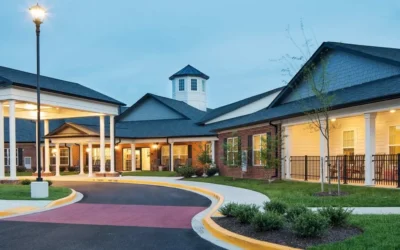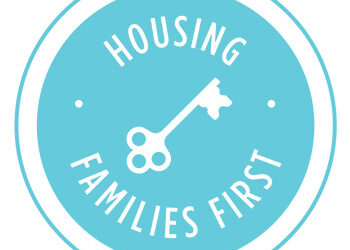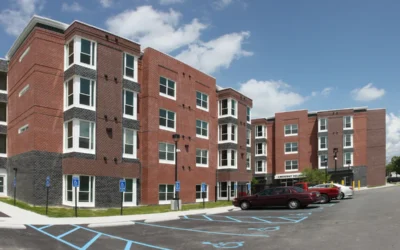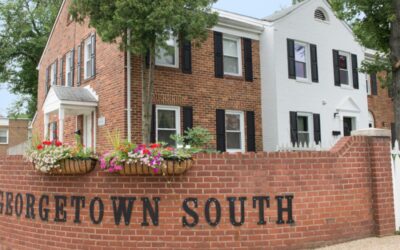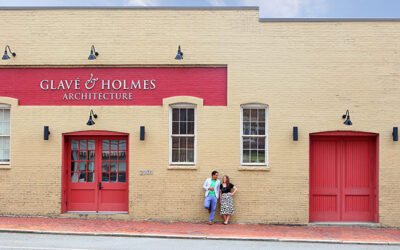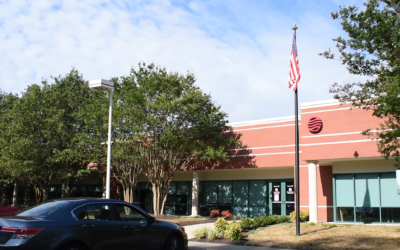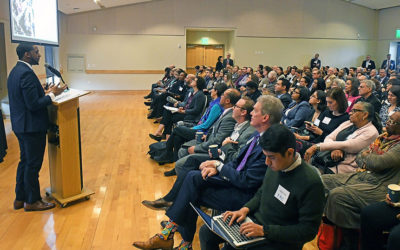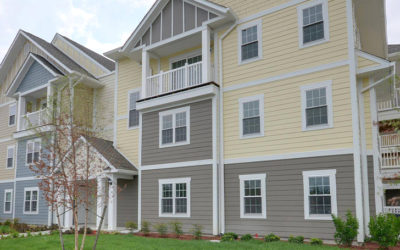The market for senior living communities – especially those with assisted living and memory care sections – remains highly competitive. Spring Arbor Senior Living was a regional senior living owner and operator with communities in Maryland, Virginia, and North Carolina. When Foundry Commercial acquired Spring Arbor they recognized the important of proactive communications to help senior living communities maintain robust census levels and attract new residents.
Showcasing Hospitality Design
Glave and Holmes Architecture, a national-recognized architecture and design firm, wanted to grow its business in the hospitality sector. The firm had a strong team and good relationships but was looking for new opportunities to expand its reach with hotel and resort developers, owners, and operators, particularly boutique and high-end hospitality.
Nonprofit Merger and Launch
Two affordable housing organizations were at a crossroads. Both groups provided a variety of support and advocacy for organizations and individuals committed to affordable housing development and homeless services. After separate strategic reviews, the groups recognized that a merger could ensure their ability to leverage additional resources to meet their missions and make a more substantial impact. Gray Ryan provided strategic consulting throughout the merger process and identified a new name, branding, and messages to help the new organization not just retain all current members but grow.
Housing Families First
Homelessness is a complex and challenging issue. There are many contributing factors that push people into homelessness. Serving those experiencing homelessness is difficult work and made even harder but persistent and inaccurate stereotypes about individuals and families experiencing homelessness. Many homeless services agencies wrestle with how to tell compelling and concise stories about their programs and impact. Housing Families First, a Richmond, VA nonprofit that serves families with children experiencing housing instability and homelessness, wanted to build greater awareness and support for its work.
Greater Richmond Continuum of Care
The Greater Richmond Continuum of Care (GRCoC) is the Richmond region’s coordinated and collaborative network of homeless service providers. The network includes 34 local, mission-driven agencies. Given the complexity of homelessness services and the pernicious stereotypes about individuals and families pushed into homelessness, clear and concise messages from all partner agencies is crucial to ensure key audiences understand the reality around homelessness and how the region is successfully and compassionately responding.
Capital Campaign and Expansion
Housing Families First, a Central Virginia nonprofit that serves families with children facing housing instability and homelessness, was approaching the end of a highly successful capital campaign. The campaign, which was the largest in the organization’s history, raised over $4.5 million to expand its campus and programs serving families. Housing Families First wanted to build on this momentum and celebrate its newly expanded campus.
5000 Families Pilot Program
Challenge: The Virginia Housing Alliance is seeking support from the Virginia General Assembly to launch a new pilot program designed to provide $100M in rent relief over a two-year period to 5,000 low-income families with school-aged children across Virginia. Managed by the Department of Housing and Community Development, the 5000 Families pilot program will empower families and set up students for success. To build support for the 5,000 Families program, a comprehensive and strategic advocacy and public relations campaign would be needed.
Supportive Housing Campaign
Challenge: Virginia Supportive Housing is the largest statewide non‐profit organization that serves homeless adults by providing permanent, supportive housing. In conjunction with its 25th anniversary, Virginia Supportive Housing was seeking to expand its footprint in Hampton Roads with the development of several new communities. To facilitate that growth, it needed to communicate the importance of permanent, supportive housing to both the general public in the cities of Virginia Beach and Norfolk as well as elected officials.
Georgetown South 50th Anniversary
Challenge: Georgetown South is a master-planned, townhome community home to 1,000 residents in the city of Manassas, just 30 miles from the heart of Washington, D.C. As a result of the Great Recession, the community was facing a crisis due to high foreclosure rates, increased crime, and deteriorating conditions of the amenities. A housing advocacy group built a coalition of financial partners including Bank of America and the Virginia Housing Development Authority to stabilize Georgetown South through the development of new amenities, crime prevention programs, and the introduction of new financing tools which would allow the homes to remain affordable.
Chesapeake Square Mall
Challenge: An underperforming mall in Chesapeake, Virginia fell into foreclosure in 2016 after several anchor tenants closed their operations. The 717,000 sq./ft. mall quickly became an eye-sore to the Western Branch community as the lender refused to make any substantial investments. In 2018, Virginia Beach-based Kotarides Holdings purchased the property as part of a strategic plan to revitalize the area and make it a destination for new business and residents.
HHHunt
Challenge: One of the largest developers in the Mid-Atlantic, HHHunt Corporation develops, builds, and manages residential real estate communities, including new homes and apartments, in Maryland, Virginia, North Carolina, and South Carolina. The company set ambitious growth goals across its various markets to fuel long-term expansion plans. These efforts would require a sustained and strategic marketing campaign across HHHunt’s footprint.
2000 West Creek
Challenge: A Tennessee-based multifamily developer was looking to re-enter the Greater Richmond market with the development of two new projects representing a $110 million investment. One of those projects was 2000 West Creek. Located in the West Creek submarket, the asset was the first of its kind to be built in the area and represented a major departure from the traditional multifamily communities nearby based on size, amenities offered, and floor plans.
Senior Living Portfolio
Challenge: A national REIT decided to consolidate its senior living portfolio under one operator in order to enhance profitability. This meant that the remaining operator would need to on-board 10 new communities into its portfolio within a three-month period. Both the REIT and the operator wanted to share news about the consolidation with senior living industry publications and local news organizations where the communities were located. They also wanted to create a seamless digital transition on social media.
Class A Office Tower
Challenge: Due to a number of events, the vacancy rate of a 30-year-old, 26-story, Class A office building in Richmond, Virginia’s central business district climbed to 25 percent. As a result, the owner of the building hired a new regional commercial brokerage firm to manage the leasing process for the asset. Both the owner and the brokerage firm wanted to communicate the new relationship and highlight planned improvements to the building in order to increase the number of tenants and encourage lease renewals of existing tenants.
Abberly Avera
Challenge: The multifamily market in Northern Virginia is both highly competitive and lucrative. HHHunt Apartment Living had entered the market and experienced success with its first new community in the region. Abberly Avera would become one of its most ambitious projects and represented a total investment of over $60 million. Reaching potential residents during construction and lease up would be critical to the community’s viability.
Westwood Tract Development
Challenge: When Union Presbyterian Seminary sold a parcel of land adjacent to its campus to a leading national multifamily developer, a vocal group of neighbors organized to block the development. Despite the need for new, quality housing in the community, this classic NIMBY effort played out in legal courts and the court of public opinion, threatening the development’s viability and Union’s long-standing reputation.
Emerald Homes
Challenge: The Great Recession was a difficult time for home builders. Sales of new homes plummeted to historic lows. Emerald Homes, had a presence in Powhatan County, New Kent County, Prince George County, and Chesterfield County but sales had completely dried up in 2008.
Glave & Holmes Architecture
Challenge: Celebrating five decades of success, Glave & Holmes Architecture was known for its traditional and classical style. Based in Virginia, the firm had evolved significantly during its history and had ambitious growth plans in both existing and new markets. The firm wanted to reintroduce itself to current and potential clients and better highlight its incredible work to support business development efforts.
Signature Lease Negotiations
Challenge: A large owner of office, retail, and industrial space in Hampton Roads, VA undertook a strategic decision to bring its leasing operations in-house in order to maximize its ability to negotiate with current and prospective tenants. Gray Ryan Communications helped the leadership of KPM create a comprehensive public relations campaign designed to highlight signature lease negotiations that the company was able to undertake with the new arrangement and to showcase that these leases demonstrated how the company was ready to make deals that benefited the end-user, local community, and the owner.
Providence
Challenge: A master-planned new home community in Ashland, Virginia, Providence began development in 2012 at a time when home sales continued to lag due to the effects of the Great Recession. The developer wanted to build excitement about Providence by replicating the small-town charm of Ashland within the community. That meant creating an environment that promoted walkability, created natural gathering spaces, encouraged neighbor interaction, and had the feel of a close-knit community.
Draper Aden Associates
Challenge: Draper Aden Associates, an engineering, surveying, and environmental services firm, had an impressive project list and lengthy roster of clients in Virginia, but had not gained earned media coverage in a number of years and was having trouble expanding its reach to the broader Mid-Atlantic region. The firm recognized the need to raise awareness in new markets about its powerful track record of success and growing services. Furthermore, the engineering sector was becoming increasingly competitive.
Virginia Tech Land Development and Design Initiative
Challenge: Virginia Tech Land Development and Design Initiative’s activities have been funded almost exclusively through annual corporate sponsorship. With financial support on the decline, LDDI’s leaders recognized the need to enhance the program’s reputation among the private land development community.
Richmond Regional Housing Framework
Challenge: Similar to many communities around the country, the Greater Richmond region in Central Virginia was facing a growing housing crisis. Yet, awareness and urgency to act was lagging. The Partnership for Housing Affordability (PHA) recognized the need to galvanize support around this issue and provide tangible solutions. The result was the Richmond Regional Housing Framework, a report that addressed the region’s shared housing challenges and provided dozens of regional and hyper-local solutions.
The Village at Gateway
Challenge: South Norfolk was an economically distressed area in Chesapeake, VA that needed a new vision. That catalyst for change was The Village at Gateway. The developer of The Village at Gateway saw a brighter future for the historic community that included a dynamic mixed-use community with retail and office space, condos, and community amenities, such as a new public library. However, the developer needed, and lacked, support from neighbors and community leaders to make this vision a reality.
Branch Builds
Challenge: After 55 years in business, Roanoke, Virginia-based Branch & Associates, a general contracting firm, was facing tremendous competition in three markets where it has offices: Richmond, VA; Herndon, VA (Northern Virginia/metro DC); and Charlotte, NC. In the highly competitive construction field, name recognition is essential to winning new business. Senior leaders recognized a need to reintroduce the company in these new markets in order to grow business opportunities. Branch & Associates became Branch Builds – a name that better reflected the firm’s work and could highlight their expertise.

